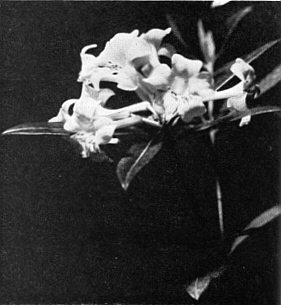QBARS - v28n3 R. 'Princess Alexandra'
R. 'Princess Alexandra'
E. White Smith, Jr., Tacoma, Washington

|
|
FIG. 53. Early Malesian hybrid,
'Princess Alexandra' was named over 100 years ago. Photo by E. White Smith |
When we see a rhododendron hybrid bloom, which was introduced over one hundred years ago, often times we are motivated to research its history. It is exciting to learn its parentage and when and who did the cross. The plant which I bloomed for the first time this January is R . 'Princess Alexandra', a Malesian or Vireya type. It is a very tender plant but also seems to be quite durable. It does not seem to be too particular about potting soil, fertilizer, water, insects or warm temperature. It is strictly a greenhouse plant. Plants seem to grow well in a light potting soil of peat and shredded Styrofoam. We, in the northwestern United States, can not easily obtain the fern log to use as a planting medium as our Australian friends can. I also find that a feeding of fish fertilizer works well.
My plant is small now, only one and one-half feet tall, and growing in a five inch pot. It is nicely branched and had seven flower buds. The buds open pale green but soon turn to white as they open. A very slight pink tint is in the white flower color which I expected to darken. It is quite typical of many Malesian Rhododendrons for colors to get more intense. But, no such thing happened, the flowers remained white. The flower buds themselves stayed small and un-swollen for a long time but then began to swell and opened rapidly with seven flowers in a loose truss. The flowers themselves are held stiffly in place by a long strong pedicel. The blooms are not overly large, being only one and one-half inches long. The leaves are three and one-half inches long and three-fourths inches broad.
In the Journal of the Royal Horticultural Society of 1891, there is an article titled "Hybrid Rhododendrons" by the Rev. Professor G. Henslow. He wrote about the hybrids made from a very few species, which Messrs. Veitch & Sons crossed in the mid and late 1800's. We find that R. javanicum was introduced in 1823 and R. jasminiflorum in 1850. These two species were crossed to make the first hybrid Vireya rhododendron named 'Princess Royal'. Then 'Princess Royal' was crossed with R. jasminiflorum to make the hybrid plant 'Princess Alexandra'.
The early English growers working with this type of rhododendron had only seven species to play with. They were R. brookeanum (straw colored to orange), R. lobbii (crimson), R. jasminiflorum (white), R. multicolor var. cirtisii (lemon and crimson), R. javanicum (orange), R. teysmannii (golden yellow) and R. malayanum (cerise). According to Mr. Sleumer this list of available species could be cut even shorter since R. teysmannii is very close to R. javanicum . In Mr. Sleumer's book, "An Account of Rhododendrons in Malesia", he says that only 30 to 40 species have been introduced to horticulture by way of seed or cuttings. Mr. Sleumer lists approximately 288 species in his book or about one-third of the species in the rhododendron genus. We have much to look forward to in the Malesian rhododendrons in the coming years. They are so entrancingly different and interesting and will surely capture the hearts of many of us rhododendron fanciers.
